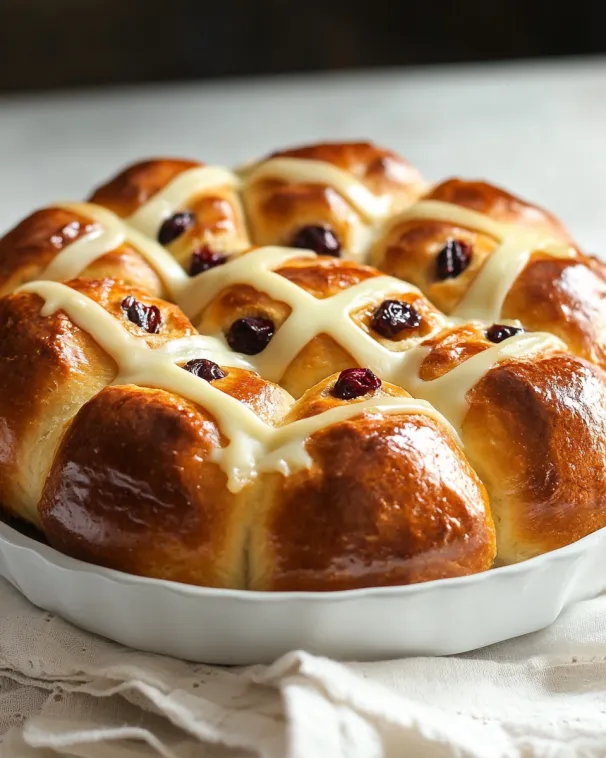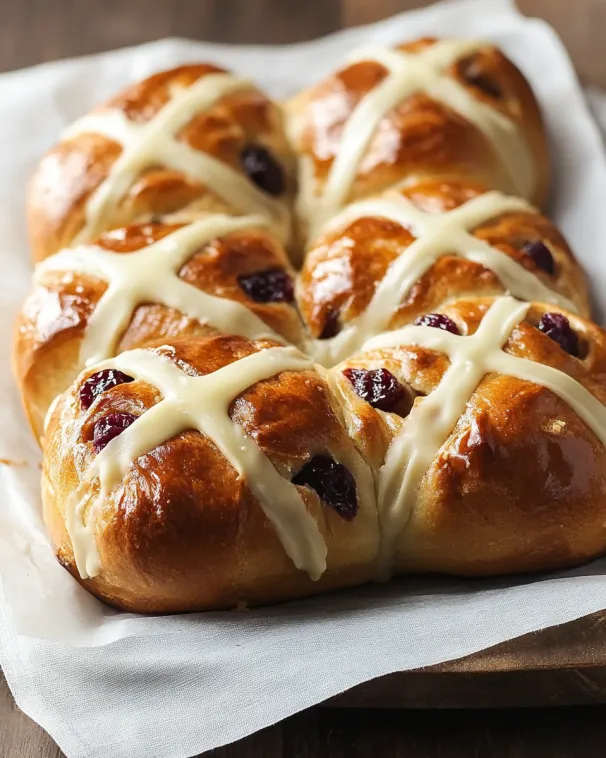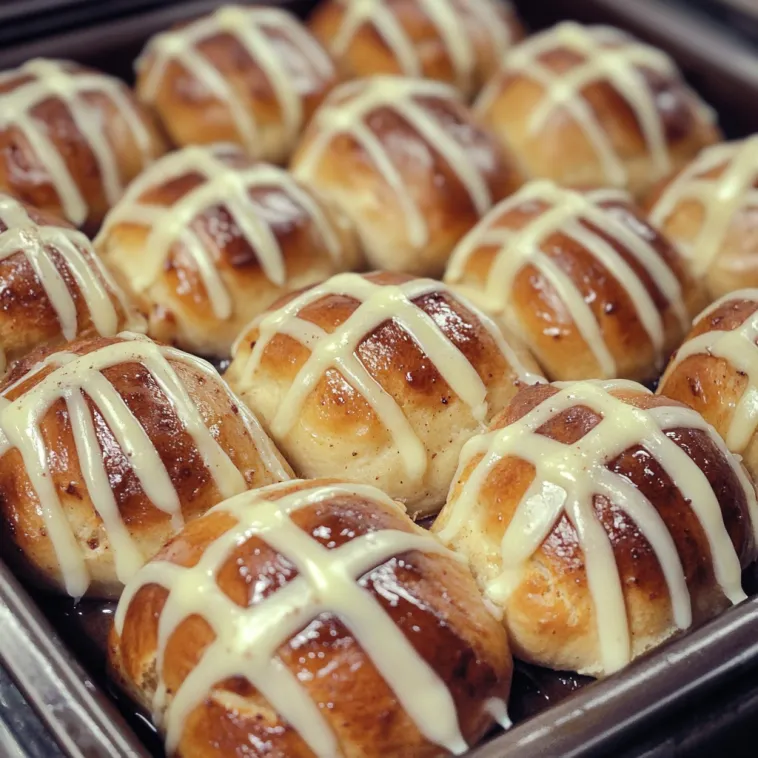 Bookmark
Bookmark
This traditional British Hot Cross Bun recipe has been passed down through generations in my family, originating from a Tudor spiced bun recipe my mother discovered in the 1950s. The aromatic spices and plump fruits create the perfect Easter treat that brings back cherished childhood memories of warm kitchens and holiday traditions.
I remember my mother making these every Easter, the house filling with the most incredible aroma of cinnamon and mixed spice. Now my own family gathers in anticipation when they smell these baking, knowing a special treat awaits.
Ingredients
- Strong white bread flour: provides the perfect structure for these rich buns
- Salt: enhances all the flavors and balances the sweetness
- Mixed spice and cinnamon: create that classic hot cross bun aroma
- Butter: adds richness and tender crumb
- Caster sugar: for just the right amount of sweetness
- Easy blend dried yeast: ensures reliable rising
- Free range egg: for binding and richness
- Mixed dried fruit and mixed citrus peel: for authentic flavor and texture
- Plain flour: for creating the iconic crosses
- Milk: for glazing creates that beautiful shiny top
Step-by-Step Instructions
- Prepare the dough:
- Sift flour with salt and spices into a large bowl. This aerates the flour and distributes spices evenly. Rub butter into flour until it resembles fine breadcrumbs. Create a well in center, add sugar and yeast, then beat egg with tepid milk before adding to the bowl. Mix until you have a soft, pliable dough.
- Incorporate the fruit:
- Turn dough onto a lightly floured surface and carefully work dried fruit and citrus peel into the dough. This takes patience to ensure even distribution. Knead for 5 minutes until smooth and elastic. The dough should feel alive under your hands, bouncing back when pressed gently.
- First prove:
- Shape dough into a ball and place in a buttered bowl. Cover with a clean tea towel and leave in a warm place for one hour. The dough should double in size and feel light and puffy when touched.
- Knock back and second rise:
- Turn proved dough onto a floured surface and gently punch down to release air bubbles. Reshape into a ball, return to bowl, cover again and set aside for another 30 minutes to rise further, developing more flavor and texture.
- Shape the buns:
- Divide dough into 12 equal pieces. Roll each piece into a ball, then slightly flatten into bun shapes. Cover and rest 5-10 minutes to relax the gluten. Meanwhile, prepare cross mixture by combining plain flour with enough water to make a pipeable paste.
- Final prove:
- Place buns on greased baking trays inside a large oiled plastic bag. Tie tightly and leave in a warm place for 40 minutes until well risen and puffy to the touch.
- Bake to perfection:
- Preheat oven to 240°C/220°C Fan. Remove buns from bag, pipe crosses on top, and bake 15-18 minutes until golden. They should sound hollow when tapped underneath. Immediately brush with sugar milk syrup while hot for that characteristic shine.
 Bookmark
Bookmark
My favorite part of this recipe is the mixed spice blend that creates that unmistakable hot cross bun aroma. When I was young, my mother would always let me pipe the crosses, and though mine were often wobbly, she insisted they were perfect. Now I let my children do the same, continuing our family tradition.
Storage Tips
These hot cross buns keep well in an airtight container at room temperature for 2-3 days. For longer storage, freeze them in a freezer bag with the air pressed out. They defrost naturally in about 6 hours, or you can use the defrost setting on your toaster for a quick treat. The texture remains remarkably good even after freezing.
 Bookmark
Bookmark
Serving Traditions
In Britain, hot cross buns are traditionally eaten on Good Friday to mark the end of Lent. They taste best when served warm, split open and spread generously with salted butter that melts into all the nooks and crannies. Some people enjoy them with a slice of sharp cheddar cheese for a sweet-savory combination, while others prefer them toasted golden with afternoon tea.
Historical Significance
Hot cross buns date back centuries, with the cross symbolizing the crucifixion of Christ. Queen Elizabeth I actually tried to ban them except at Easter and Christmas due to their Catholic associations. The spices represent those used for embalming, while the sweetness celebrates resurrection. Many households have superstitions around them, including keeping one from Good Friday all year for good luck.
Frequently Asked Questions
- → Can I make hot cross buns in advance?
Yes, these hot cross buns freeze exceptionally well for up to 3 months. Simply allow about 6 hours for them to defrost at room temperature, or use your toaster's defrost setting. They can also be made a day ahead and stored in an airtight container.
- → What is mixed spice in the ingredients?
Mixed spice is a British baking blend similar to pumpkin pie spice, typically containing cinnamon, nutmeg, allspice, cloves, ginger, and sometimes coriander. If unavailable, you can substitute with a combination of these spices, emphasizing cinnamon and nutmeg.
- → How do I know when the hot cross buns are properly baked?
The buns should be pale golden-brown on top. To test doneness, turn one over and tap the bottom - it should sound hollow. This usually takes 15-18 minutes in a preheated oven at 240°C/220°C Fan.
- → Can I use a bread machine for this hot cross bun recipe?
Yes, you can use a bread machine for the initial dough stages up to the second proving. Add the dried fruit 5 minutes before the end of kneading or when your bread machine signals. Then shape the buns by hand and complete the remaining steps as directed.
- → What's the best way to serve hot cross buns?
Hot cross buns are traditionally served warm, split in half, and spread with butter. They're also excellent toasted. For an indulgent treat, try them with clotted cream or orange marmalade alongside your morning tea or coffee.
- → Why do my hot cross buns need to prove twice?
The double proving process develops better flavor and creates the light, fluffy texture that's characteristic of traditional hot cross buns. The first rise develops the yeast flavor, while the second rise, after shaping, helps achieve the proper structure and texture.
